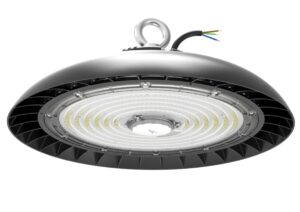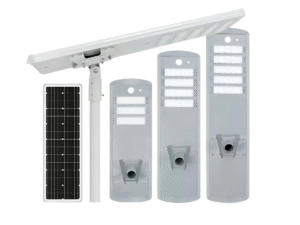Selecting the right high bay lighting is a critical decision that affects not only visibility and safety but also long-term energy costs and maintenance requirements.
Selecting the best high bay lighting for your warehouse, factory, or other large space requires careful consideration of several factors. The right lighting can enhance productivity, improve safety, and significantly reduce energy costs.
In this article, we’ll explore the key features that define quality high bay lights, compare different types, and provide guidance to help you make an informed decision for your specific application.
What is High Bay Lighting?
High bay lighting consists of ceiling-mounted luminaires designed to illuminate surfaces 15 to 25 feet away from the fixture. These lights are typically used in spaces with ceilings 4 meters (about 13 feet) or higher.
Common applications include:
Warehouses and logistics centers (illuminating high shelving for easy access and inventory counting)
Factory workshops (providing adequate lighting for production lines and machinery operation)
Large retail stores and wholesale markets
Sports venues and gymnasiums
Aircraft hangars, transportation hubs, and exhibition halls
Key Considerations When Choosing High Bay Lights
- Lighting Technology: LED Dominates
When it comes to high bay lighting, LED technology has become the preferred choice over traditional options like metal halide (MH), high-pressure sodium (HPS), or fluorescent lighting.
Here’s why:
Energy Efficiency: LED high bay lights can reduce energy consumption by 50% or more compared to traditional metal halide or high-pressure sodium options. For example, one case study showed that replacing 400W traditional MH lights with 140W LED fixtures resulted in over 60% energy savings.
Long Lifespan: Quality LED high bay lights can last 50,000 hours or more, significantly reducing maintenance costs and frequency of replacements.
Instant On: Unlike HID options that require minutes to warm up, LEDs provide immediate full brightness.
Better Light Distribution: LEDs offer directional light (minimizing light spill) compared to the omnidirectional nature of traditional technologies.
- Optical Control and Glare Reduction
Advanced optical systems are crucial for high bay lighting. The newest fixtures feature specialized lenses for superior light control. For instance, some manufacturers have introduced models with refractor lenses that significantly reduce glare and improve visual comfort while maintaining high lumen output.
Proper optical design ensures that light is directed where it’s needed most, reducing eye strain and creating a more comfortable working environment. This is particularly important in settings where workers spend long hours under artificial lighting.
- Build Quality and Durability
Industrial environments demand rugged lighting solutions. Look for these features:
Robust Housing: Die-cast aluminum construction with integrated heat sinking provides both durability and effective thermal management.
Protection Ratings: An IP65 rating or higher ensures protection against dust and moisture, which is crucial for environments like cold storage facilities or washdown areas.
Surge Protection: 6KV surge protection helps safeguard your investment against voltage spikes.
Vibration Resistance: For environments with heavy machinery, look for fixtures rated for 3G vibration testing.
- Thermal Management
Effective thermal management is critical for LED longevity and performance. Some advanced LED drivers incorporate thermal foldback protection—a feature that reduces LED current when temperatures rise excessively, protecting the LEDs from premature failure and maintaining safe operating conditions.
This technology uses negative temperature coefficient (NTC) thermistors placed near the LEDs to monitor temperature. As temperature rises beyond a set point, the resistance decreases, triggering a reduction in output current.
- Selectable Features and Flexibility
Many modern LED high bay lights offer selectable wattage and color temperature options, adjustable with a simple switch. This allows for on-site tuning to meet specific lighting requirements and provides greater flexibility if needs change over time. - Smart Controls Compatibility
Integrated lighting controls can deliver additional energy savings and functionality. Options include:
0-10V dimming capabilities for enhanced energy control
Occupancy sensors to automatically turn off lights in unoccupied areas
Daylight harvesting systems that adjust artificial light based on natural light levels
Networked lighting control systems that allow for centralized monitoring and management
Comparing High Bay Lighting Options
Here’s a quick comparison of different high bay lighting technologies:
| Feature | LED High Bay | Metal Halide | High-Pressure Sodium | Fluorescent |
| Energy Efficiency | Excellent (70+ lm/W) | Poor | Fair | Good |
| Lifespan | 50,000+ hours | 6,000-15,000 hours | ~24,000 hours | 7,000-15,000 hours |
| Warm-up Time | Instant | 15-30 minutes | ~10 minutes | Few seconds |
| Color Rendering | 80+ CRI (excellent) | Fair to good | Poor | Fair to good |
| Maintenance | Very low | High | Moderate | High |
| Cost | Higher initial cost, lower operating cost | Lower initial cost, higher operating cost | Moderate initial and operating cost | Low initial cost, moderate operating cost |
Installation and Maintenance Considerations
Proper installation is crucial for optimal performance and safety. High bay lights are typically installed using:
Hook mounting: The most common method, using chains and cables connected to ceiling hooks
Pole & plate mounting: A more elegant system where fixtures connect to ceiling-mounted plates
Yoke mounting: Ideal for sloped ceilings as it allows angle adjustment
For maintenance, LED high bay lights offer significant advantages. Their long lifespan means fewer replacements, and features like quick-disconnect cables simplify maintenance when needed.
Making the Right Choice for Your Space
When selecting high bay lighting, consider these specific application factors:
Ceiling Height: For ceilings between 4-8 meters, standard high bay lights work well. For heights exceeding 8 meters, you may need higher power fixtures or increased fixture density.
Environment: Choose appropriate IP ratings—IP65 for outdoor or harsh environments, explosion-proof ratings for hazardous locations, and cold-tolerant versions for refrigerated spaces.
Color Temperature: For industrial work areas, 5000K cool white is often recommended for its alertness-enhancing properties. 4000K natural light may be preferable in warehouses.
Beam Angle: Narrower beam angles (60-120 degrees) help prevent light spill and provide more focused illumination.
Conclusion: Investing in Quality High Bay Lighting
Choosing the best high bay lighting involves much more than simply selecting the brightest fixture. The optimal solution balances performance, efficiency, durability, and total cost of ownership.
LED technology currently represents the best choice for most applications, offering superior energy efficiency, longer lifespan, and better light quality than traditional alternatives. When selecting your high bay lights, prioritize quality manufacturers that offer robust construction, advanced thermal management, and features like selectable wattage and color temperature for future flexibility.
Remember, the cheapest option upfront often becomes the most expensive in the long run when factoring in energy consumption and maintenance costs. Investing in high-quality LED high bay lighting from a reputable manufacturer will deliver years of reliable service while significantly reducing your operational expenses.
For specific applications, consult with a lighting specialist who can provide detailed recommendations based on your space dimensions, ceiling height, and operational requirements.


